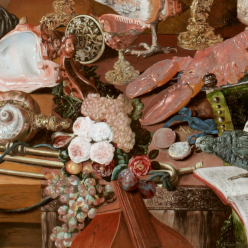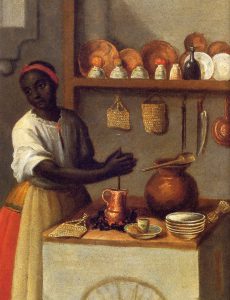
No. 4. De español y negra, nace mulata
Andrés de Islas, Mexico, 1774
Oil on canvas
75 x 54 cm
Museo de América, Madrid
de Islas, Andrés. No. 4. De español y negra, nace mulata (From Spaniard and Black, a Mulata is Born). 1774. Oil on canvas. Museo de América, Madrid. In Casta Painting: Images of Race in Eighteenth-Century Mexico. New Haven: Yale University Press, 2004, 116.
Andrés de Islas produced this painting in Mexico as part of a series of casta paintings that introduce the Black African-Spaniard lineage. Although the purpose for commissioning such paintings are not well understood, casta paintings are theorized to have served as a souvenir for wealthy European audiences. This enabled them to have a unique glimpse of colonial life. In effect, this painting would have been a part of a series that depicts the racial hierarchy of Latin America.
Islas introduces the concept of Black African-Spaniard lineage in this painting by depicting a violent domestic encounter between a Black African woman and a Spanish man. In this conflict, the Black African woman grabs the hair of a Spanish man and is about to strike him with a kitchen utensil. In response, the Spanish man expresses shock while protecting himself from getting injured. In the midst of this conflict, their mulatto daughter pushes on her mother’s leg. In the painting, Islas highlights the various exotic fruits and vegetables in Latin America by comparing them to the oddity of the Spaniard-Black African couple and their mulatto daughter.
In the seventeenth century, elite members of society exerted great power over those of African descent and enforced rigorous laws after Africans incited a mass riot in 1611. In the eighteenth century, the elite members of Latin American society saw that the categories of the Latin American caste system were deteriorating. However, they commissioned paintings which continued to illustrate a taxonomy of castas that was no longer functioning. Appealing to a foreign audience, Europeans and elite members of Latin American society may have commissioned a casta painting like this one to enforce the ideals of a deteriorating casta system and maintain exclusive economic privileges.
In doing so, they resisted the social advancement of Africans, who were acquiring the power to purchase whiteness and attain social mobility. Elite members of society responded in protest to this and complained that those of African descent were “people who in our houses one would not give a seat”.[1] To express their fear of those of African descent, the elite commissioned paintings that displayed them in unstable domestic settings. Moreover, to emphasize the debased social dynamic that a household with one of purely African blood could create, Islas juxtaposes this painting with more stable households characterized by familial members who produce children with fair skin.
[1] Ann Twinam, “Purchasing Whiteness,” in Imperial Subjects: Race and Identity in Colonial Latin America, ed. Andrew B. Fisher and Matthew D. O’Hara (Durham: Duke University Press, 2009), 152.
Sources:
Carrera, Magali. Imagining Identity in New Spain. Austin: University of Texas Press, 2003.
Katzew, Ilona. Casta Painting : Images of Race in Eighteenth-Century Mexico. New Haven: Yale University Press, 2004.
Twinam, Ann, “Purchasing Whiteness,” in Imperial Subjects: Race and Identity in Colonial Latin America, ed. Andrew B. Fisher and Matthew D. O’Hara. Durham: Duke University Press, 2009, 141-165.

